This page will be dedicated to a few of the outstanding science highlights generated through the use of NASA's R&A (including DA) funds. Please send us information on a result that you think is especially worth noting, and include the program from which funding was received. Feel free to submit your own work or that of a colleague who may be too shy to do so themselves. The Highlights will be posted in a random order, and we will number them sequentially only to help you find them as the list grows. You can find an index of the highlights here with a short version of the title.
- Water Vapor Major Player in Climate Change
- The most ice on Mars outside the polar caps
- Space Telescope Discovers First Gamma-Ray-Only Pulsar
- Rising Arctic Storm Activity and Sea Ice and Climate
- Life Without the Sun
- Ulysses Reveals Global Solar Wind Plasma Output At 50-Year Low
- Happy 5th Birthday Spitzer, I got a Kuiper Belt for you
- Cassini Images Ring Arcs Among Saturn's Moons
- Scientists Detect Cosmic "Dark Flow" Across Half the Universe
- Voyager Squashes View of Solar System
- Stellar Baby Boom
67. Water Vapor Major Player in Climate Change
 Water vapor is known to be Earth’s most abundant greenhouse gas, but the extent of its contribution to global warming has been debated. Using Atmospheric Infrared Sounder (AIRS) on NASA’s Aqua satellite Andrew Dessler and co-authors Z. Zhang & P. Yang of Texas A&M University, College Station have estimated more precisely than ever the heat-trapping effect of water in the air, validating the role of the gas as a critical component of climate change. This research confirms that the heat-amplifying effect of water vapor is potent enough to double the climate warming caused by increased levels of carbon dioxide in the atmosphere. The work appears in “Water-vapor climate feedback inferred from climate fluctuations, 2003–2008� in Geophysical Research Letters. More on this article can be found at ScienceDaily.com and the web release from GSFC.
Water vapor is known to be Earth’s most abundant greenhouse gas, but the extent of its contribution to global warming has been debated. Using Atmospheric Infrared Sounder (AIRS) on NASA’s Aqua satellite Andrew Dessler and co-authors Z. Zhang & P. Yang of Texas A&M University, College Station have estimated more precisely than ever the heat-trapping effect of water in the air, validating the role of the gas as a critical component of climate change. This research confirms that the heat-amplifying effect of water vapor is potent enough to double the climate warming caused by increased levels of carbon dioxide in the atmosphere. The work appears in “Water-vapor climate feedback inferred from climate fluctuations, 2003–2008� in Geophysical Research Letters. More on this article can be found at ScienceDaily.com and the web release from GSFC.
66. The most ice on Mars outside the polar caps
 In "Radar Sounding Evidence for Buried Glaciers in the Southern Mid-Latitudes of Mars� in the Nov 21st issue of the journal science Holt et al., showed that there are vast glaciers of water ice much further south on Mars, than previously known using ground-penetrating radar on NASA's Mars Reconnaissance Orbiter. "Altogether, these glaciers almost certainly represent the largest reservoir of water ice on Mars that's not in the polar caps," said John Holt of the University of Texas at Austin and the main author of the study. "Just one of the features we examined is three times larger than the city of Los Angeles and up to one-half-mile thick, and there are many more." For more information see the web story from the MRO page.
In "Radar Sounding Evidence for Buried Glaciers in the Southern Mid-Latitudes of Mars� in the Nov 21st issue of the journal science Holt et al., showed that there are vast glaciers of water ice much further south on Mars, than previously known using ground-penetrating radar on NASA's Mars Reconnaissance Orbiter. "Altogether, these glaciers almost certainly represent the largest reservoir of water ice on Mars that's not in the polar caps," said John Holt of the University of Texas at Austin and the main author of the study. "Just one of the features we examined is three times larger than the city of Los Angeles and up to one-half-mile thick, and there are many more." For more information see the web story from the MRO page.
65. Space Telescope Discovers First Gamma-Ray-Only Pulsar
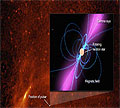 Using Data from the Fermi Space Telescope the first known pulsar that only "blinks" in gamma rays was discovered. A pulsar is a rapidly spinning neutron star, the crushed core left behind when a massive sun explodes. Most pulses are found at radio wavelengths, some of these objects also beam energy in other forms, including visible light and X-rays. Scientists think the region that emits the pulsed gamma rays is broader than that responsible for pulses of lower-energy radiation. The Fermi Telescope (the telescope formerly known as GLAST) scans the entire sky every three hours and detects photons with energies ranging from 20 million to more than 300 billion times the energy of visible light. The instrument sees about one gamma ray every minute. The principal investigator for Fermi's Large Area Telescope is Peter Michelson, of Stanford University in Palo Alto.
Using Data from the Fermi Space Telescope the first known pulsar that only "blinks" in gamma rays was discovered. A pulsar is a rapidly spinning neutron star, the crushed core left behind when a massive sun explodes. Most pulses are found at radio wavelengths, some of these objects also beam energy in other forms, including visible light and X-rays. Scientists think the region that emits the pulsed gamma rays is broader than that responsible for pulses of lower-energy radiation. The Fermi Telescope (the telescope formerly known as GLAST) scans the entire sky every three hours and detects photons with energies ranging from 20 million to more than 300 billion times the energy of visible light. The instrument sees about one gamma ray every minute. The principal investigator for Fermi's Large Area Telescope is Peter Michelson, of Stanford University in Palo Alto.
For more information see the paper by Abdo et al ‘The Fermi Gamma-Ray Space Telescope Discovers the Pulsar in the Young Galactic Supernova Remnant CTA 1’ appeared in the Oct. 16 edition of Science Express or read the science blog on this subject.
64. Rising Arctic Storm Activity and Sea Ice and Climate
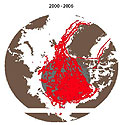 A team led by NASA researcher Sirpa Hakkinen analyzed 56 years of storm track data from earlier studies and annual data on atmospheric wind stress, an established indicator of storm activity. The data confirmed an accelerating trend in storm activity in the Arctic from 1950 to 2006 which enabled them to not only link climate to storminess, but to also connect increasing trends in arctic storminess and the movement of arctic ice. For more information you can read or the article ‘Sea ice drift in the Arctic since the 1950s’ by Hakkinen, Proshutinsky & Ashik, which appeared this month in Geophysical Research Letters or the NASA web release.
A team led by NASA researcher Sirpa Hakkinen analyzed 56 years of storm track data from earlier studies and annual data on atmospheric wind stress, an established indicator of storm activity. The data confirmed an accelerating trend in storm activity in the Arctic from 1950 to 2006 which enabled them to not only link climate to storminess, but to also connect increasing trends in arctic storminess and the movement of arctic ice. For more information you can read or the article ‘Sea ice drift in the Arctic since the 1950s’ by Hakkinen, Proshutinsky & Ashik, which appeared this month in Geophysical Research Letters or the NASA web release.
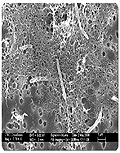 An ecosystem 2.8 kilometers underground in the Mponeng Gold Mine near Johannesburg, South Africa found 2 years ago by members of the NASA Astrobiology Institute (NAI) Indiana-Princeton-Tennessee Astrobiology Initiative (IPTAI) has recently been shown to comprise only a single species of microbe, existing on energy from radioactivity, completely independently of the Sun. Such communities are of great interest to astrobiologists as models of organisms that could live in the subsurface of other planets. Read the article by Chivian et al., “Environmental Genomics Reveals a Single-Species Ecosystem Deep Within Earth� Science 322, pp. 275-278, or the NewScientist article online.
An ecosystem 2.8 kilometers underground in the Mponeng Gold Mine near Johannesburg, South Africa found 2 years ago by members of the NASA Astrobiology Institute (NAI) Indiana-Princeton-Tennessee Astrobiology Initiative (IPTAI) has recently been shown to comprise only a single species of microbe, existing on energy from radioactivity, completely independently of the Sun. Such communities are of great interest to astrobiologists as models of organisms that could live in the subsurface of other planets. Read the article by Chivian et al., “Environmental Genomics Reveals a Single-Species Ecosystem Deep Within Earth� Science 322, pp. 275-278, or the NewScientist article online.
62. Ulysses Reveals Global Solar Wind Plasma Output At 50-Year Low
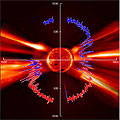 Data from the Ulysses spacecraft show the Sun has reduced its output of solar wind to the lowest levels since accurate readings became available. In 2007, Ulysses made its third rapid scan of the solar wind and magnetic field from the sun's south to north pole. When the results were compared with observations from the previous solar cycle, the strength of the solar wind pressure and the magnetic field strength near the spacecraft has decreased by 36 percent. The significant, long-term trend to lower dynamic pressures means that the heliosphere has been shrinking and the heliopause must be moving inward toward the Voyager spacecraft. Read the article "Weaker Solar Wind from the Polar Coronal Holes and the Whole Sun" by McComas et al., published in Geophysical Research Letters, 35, L18103, doi:10.1029/2008GL034896, the NASA web release a popular press Article online at Spaceflight now, or visit the Ulysses mission on the web for more information.
Data from the Ulysses spacecraft show the Sun has reduced its output of solar wind to the lowest levels since accurate readings became available. In 2007, Ulysses made its third rapid scan of the solar wind and magnetic field from the sun's south to north pole. When the results were compared with observations from the previous solar cycle, the strength of the solar wind pressure and the magnetic field strength near the spacecraft has decreased by 36 percent. The significant, long-term trend to lower dynamic pressures means that the heliosphere has been shrinking and the heliopause must be moving inward toward the Voyager spacecraft. Read the article "Weaker Solar Wind from the Polar Coronal Holes and the Whole Sun" by McComas et al., published in Geophysical Research Letters, 35, L18103, doi:10.1029/2008GL034896, the NASA web release a popular press Article online at Spaceflight now, or visit the Ulysses mission on the web for more information.
61. Happy 5th Birthday Spitzer, I got a Kuiper Belt for you
 The Spitzer Space Telescope celebrated its fifth birthday recently with jewel-like forming stars in M5 (see telegraph.co.uk) and as a special gift got a belt. A Kuiper Belt-like structure around HD 181327, a sun-like star in the constellation of Pictor, to be specific. These observations were made by a team lead by Christine Chen of Space Telescope Science Institute using Hubble, Gemini South, and Spitzer. This result is reported in Chen, Fitzgerald, & Smith ‘Possible Icy Kuiper Belt around HD 181327’ Astrophys. J. (submitted). For more information see the preprint at http://arxiv.org/abs/0808.2273 and the nature news coverage.
The Spitzer Space Telescope celebrated its fifth birthday recently with jewel-like forming stars in M5 (see telegraph.co.uk) and as a special gift got a belt. A Kuiper Belt-like structure around HD 181327, a sun-like star in the constellation of Pictor, to be specific. These observations were made by a team lead by Christine Chen of Space Telescope Science Institute using Hubble, Gemini South, and Spitzer. This result is reported in Chen, Fitzgerald, & Smith ‘Possible Icy Kuiper Belt around HD 181327’ Astrophys. J. (submitted). For more information see the preprint at http://arxiv.org/abs/0808.2273 and the nature news coverage.
60. Cassini Images Ring Arcs Among Saturn's Moons
 NASA's Cassini spacecraft has detected a faint, partial ring orbiting with one small moon of Saturn and confirmed the presence of another partial ring orbiting with a second moon. This is further evidence that most of the planet's small, inner moons orbit within partial or complete rings. Recent Cassini images show material, called ring arcs, extending ahead of and behind the small moons Anthe and Methone in their orbits. The new findings indicate that the gravitational influence of nearby moons on ring particles might be the deciding factor in whether an arc or complete ring is formed. This is the first detection of an arc of material near Anthe. The Methone arc was previously detected by Cassini’s Magnetospheric Imaging Instrument, and the new images confirm its presence. Previous Cassini images show faint rings connected with other small moons either embedded within or near the outskirts of Saturn's main ring system, such as Pan, Janus, Epimetheus, and Pallene. Cassini has also previously observed an arc in the G ring, one of Saturn's faint, major rings. Popular science articles on this observation can be found at space.com and spaceref.com and higher resolution version of these images can be found at http://ciclops.org/view/5154/Anthe_and_Methone_Arcs.
NASA's Cassini spacecraft has detected a faint, partial ring orbiting with one small moon of Saturn and confirmed the presence of another partial ring orbiting with a second moon. This is further evidence that most of the planet's small, inner moons orbit within partial or complete rings. Recent Cassini images show material, called ring arcs, extending ahead of and behind the small moons Anthe and Methone in their orbits. The new findings indicate that the gravitational influence of nearby moons on ring particles might be the deciding factor in whether an arc or complete ring is formed. This is the first detection of an arc of material near Anthe. The Methone arc was previously detected by Cassini’s Magnetospheric Imaging Instrument, and the new images confirm its presence. Previous Cassini images show faint rings connected with other small moons either embedded within or near the outskirts of Saturn's main ring system, such as Pan, Janus, Epimetheus, and Pallene. Cassini has also previously observed an arc in the G ring, one of Saturn's faint, major rings. Popular science articles on this observation can be found at space.com and spaceref.com and higher resolution version of these images can be found at http://ciclops.org/view/5154/Anthe_and_Methone_Arcs.
59. Scientists Detect Cosmic "Dark Flow" Across Half the Universe
 Using data from NASA's Wilkinson Microwave Anisotropy Probe (WMAP), scientists have identified an unexpected motion in distant galaxy clusters. The cause, they suggest, is the gravitational attraction of matter that lies beyond the observable universe. Big-bang models that include inflation offer a possible explanation for the flow. Inflation is a brief hyper-expansion early in the universe's history. If inflation did occur, then the universe we can see is only a small portion of the whole cosmos. This measurement may give a way to explore the state of the cosmos before inflation occurred. The research, led by Alexander Kashlinsky of GSFC, will be reported in “A measurement of large-scale peculiar velocities of clusters of galaxies: results and cosmological implications� by Kashlinsky, Atrio-Barandela, Kocevski, & Ebeling, in the October 20 edition of Astrophysical Journal Letters, but is available now online in the eprint arXiv:0809.3734.
Using data from NASA's Wilkinson Microwave Anisotropy Probe (WMAP), scientists have identified an unexpected motion in distant galaxy clusters. The cause, they suggest, is the gravitational attraction of matter that lies beyond the observable universe. Big-bang models that include inflation offer a possible explanation for the flow. Inflation is a brief hyper-expansion early in the universe's history. If inflation did occur, then the universe we can see is only a small portion of the whole cosmos. This measurement may give a way to explore the state of the cosmos before inflation occurred. The research, led by Alexander Kashlinsky of GSFC, will be reported in “A measurement of large-scale peculiar velocities of clusters of galaxies: results and cosmological implications� by Kashlinsky, Atrio-Barandela, Kocevski, & Ebeling, in the October 20 edition of Astrophysical Journal Letters, but is available now online in the eprint arXiv:0809.3734.
58. Voyager Squashes View of Solar System
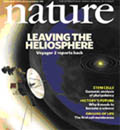 Scientists using data from NASA's Voyager 2 spacecraft have observed the bubble of solar wind surrounding the solar system is not round, but has a squashed shape, according to recent data published as part of a series of papers in the July 3 issue of Nature. In the News and Views piece “Solar System: A shock for Voyager 2� J. R. Jokipii introduces the five papers about the heliospheric termination shock measured by Voyager 2, thirty years after its launch. The five letters are:
Scientists using data from NASA's Voyager 2 spacecraft have observed the bubble of solar wind surrounding the solar system is not round, but has a squashed shape, according to recent data published as part of a series of papers in the July 3 issue of Nature. In the News and Views piece “Solar System: A shock for Voyager 2� J. R. Jokipii introduces the five papers about the heliospheric termination shock measured by Voyager 2, thirty years after its launch. The five letters are:
- “Cool heliosheath plasma and deceleration of the upstream solar wind at the termination shock,� Richardson et al;
- “Mediation of the solar wind termination shock by non-thermal ions,� Decker et al.;
- “An asymmetric solar wind termination shock,� Stone et al.;
- “Magnetic fields at the solar wind termination shock,� Burlaga et al.; and
- “Intense plasma waves at and near the solar wind termination shock,� Gurnett & Kurth.
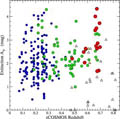 Astronomers have uncovered an extreme stellar machine -- a galaxy in the very remote universe pumping out stars at a surprising rate of up to 4,000 per year. In comparison, our own Milky Way galaxy turns out an average of just 10 stars per year.
The discovery, presented by Caputi et al., in “The Optical Spectra of 24 μm Galaxies in the COSMOS Field. I. Spitzer MIPS Bright Sources in the zCOSMOS-Bright 10k Catalog� which appeared in the June 20 2008 issue of the Astrophysical Journal, (Vol 680 pages 939–961), was made possible by several telescopes including NASA's Spitzer Space Telescope. Please see the web release “Rare 'Star-Making Machine' Found in Distant Universe“ on the NASA web page.
Astronomers have uncovered an extreme stellar machine -- a galaxy in the very remote universe pumping out stars at a surprising rate of up to 4,000 per year. In comparison, our own Milky Way galaxy turns out an average of just 10 stars per year.
The discovery, presented by Caputi et al., in “The Optical Spectra of 24 μm Galaxies in the COSMOS Field. I. Spitzer MIPS Bright Sources in the zCOSMOS-Bright 10k Catalog� which appeared in the June 20 2008 issue of the Astrophysical Journal, (Vol 680 pages 939–961), was made possible by several telescopes including NASA's Spitzer Space Telescope. Please see the web release “Rare 'Star-Making Machine' Found in Distant Universe“ on the NASA web page.
